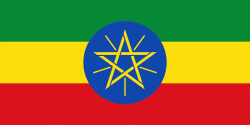Shambu
Shaamboo is a town and separate woreda in western Ethiopia. Located in the Horo Guduru Welega Zone of Oromia Region west of Lake Fincha'a, this town has an elevation of 2,503 metres above sea level. It was previously the administrative centre of Horro woreda.
A Swedish reporter published in 1969, an account of conditions in Shaamboo Prison, which consists of a fenced-in area the size of a football field, and associated buildings. A deep trench 3×5 metres in size is the common latrine for about 130 men and women. Most of the prisoners are chained, and are fed once a day. The eight female prisoners were locked in a single room 8×3 metres and never allowed outside. The men are only confined at night into two rooms 8×12 metres, 60 men in each, and sleep directly upon the wooden floor.
A Swedish reporter published in 1969, an account of conditions in Shaamboo Prison, which consists of a fenced-in area the size of a football field, and associated buildings. A deep trench 3×5 metres in size is the common latrine for about 130 men and women. Most of the prisoners are chained, and are fed once a day. The eight female prisoners were locked in a single room 8×3 metres and never allowed outside. The men are only confined at night into two rooms 8×12 metres, 60 men in each, and sleep directly upon the wooden floor.
Map - Shambu
Map
Country - Ethiopia
 |
 |
| Flag of Ethiopia | |
Anatomically modern humans emerged from modern-day Ethiopia and set out to the Near East and elsewhere in the Middle Paleolithic period. Southwestern Ethiopia has been proposed as a possible homeland of the Afroasiatic language family. In 980 BCE, the Kingdom of D'mt extended its realm over Eritrea and the northern region of Ethiopia, while the Kingdom of Aksum maintained a unified civilization in the region for 900 years. Christianity was embraced by the kingdom in 330, and Islam arrived by the first Hijra in 615. After the collapse of Aksum in 960, a variety of kingdoms, largely tribal confederations, existed in the land of Ethiopia. The Zagwe dynasty ruled the north-central parts until being overthrown by Yekuno Amlak in 1270, inaugurating the Ethiopian Empire and the Solomonic dynasty, claimed descent from the biblical Solomon and Queen of Sheba under their son Menelik I. By the 14th century, the empire grew in prestige through territorial expansion and fighting against adjacent territories; most notably, the Ethiopian–Adal War (1529–1543) contributed to fragmentation of the empire, which ultimately fell under a decentralization known as Zemene Mesafint in the mid-18th century. Emperor Tewodros II ended Zemene Mesafint at the beginning of his reign in 1855, marking the reunification and modernization of Ethiopia.
Currency / Language
| ISO | Currency | Symbol | Significant figures |
|---|---|---|---|
| ETB | Ethiopian birr | Br | 2 |
| ISO | Language |
|---|---|
| AM | Amharic language |
| EN | English language |
| OM | Oromo language |
| SO | Somali language |
| TI | Tigrinya language |















